Logistics and Supply Chain Management: A Comparative Analysis
VerifiedAdded on 2023/06/13
|7
|1427
|164
Report
AI Summary
This report provides a comprehensive overview of logistics and supply chain management, beginning with a clear differentiation between logistics, procurement, and supply chain concepts. It delves into strategic approaches within logistics, emphasizing the importance of digitalization and artificial intelligence in optimizing supply chain efficiency and reducing costs. The report further examines the critical role of transport services and logistics infrastructure in facilitating international trade, highlighting how efficient logistics systems can enhance competitiveness and enable seamless import and export activities. Finally, it contrasts Lean and Agile methodologies, outlining their distinct focuses on process improvement versus product development, and their respective impacts on customer satisfaction and resource utilization. Desklib offers a wealth of similar solved assignments and resources for students.
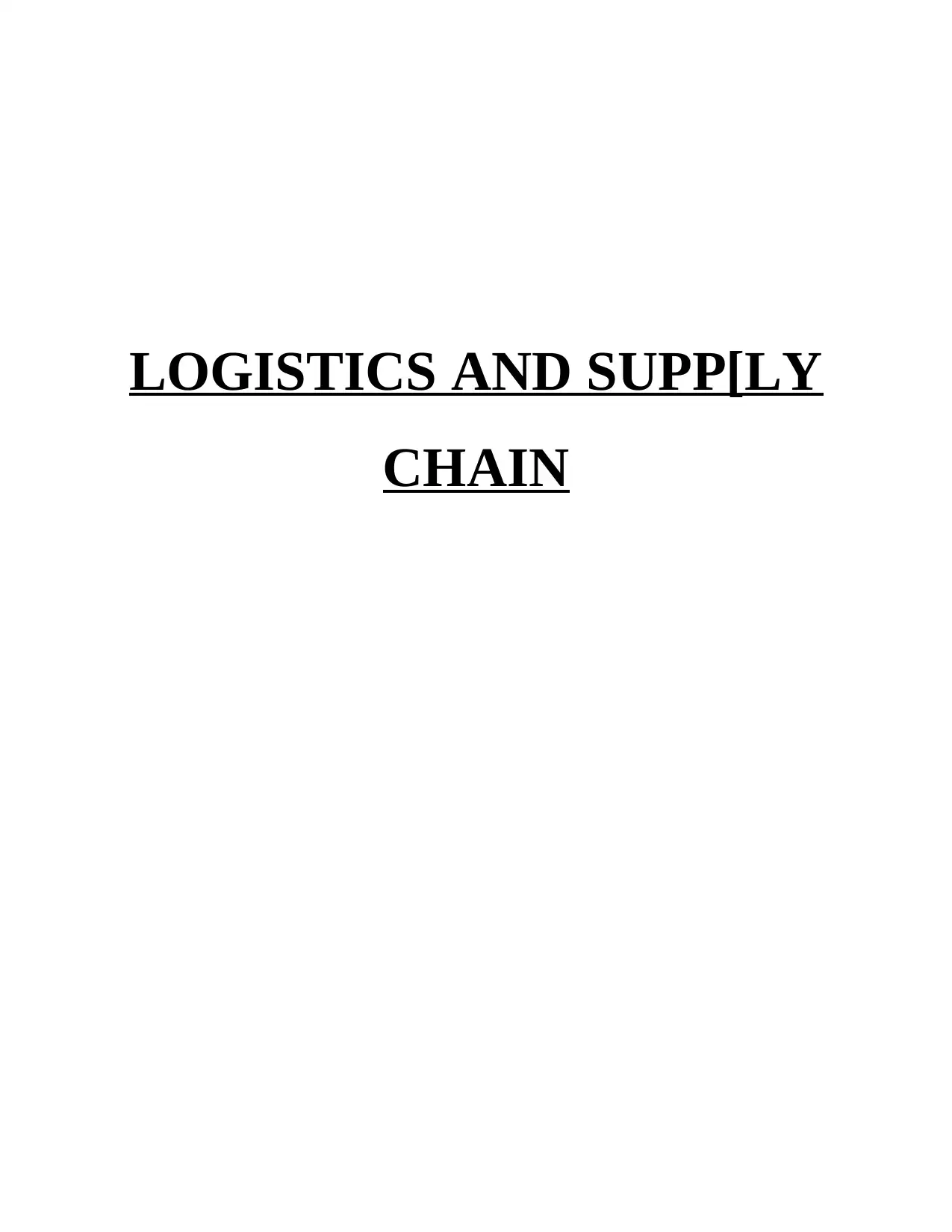
LOGISTICS AND SUPP[LY
CHAIN
CHAIN
Paraphrase This Document
Need a fresh take? Get an instant paraphrase of this document with our AI Paraphraser
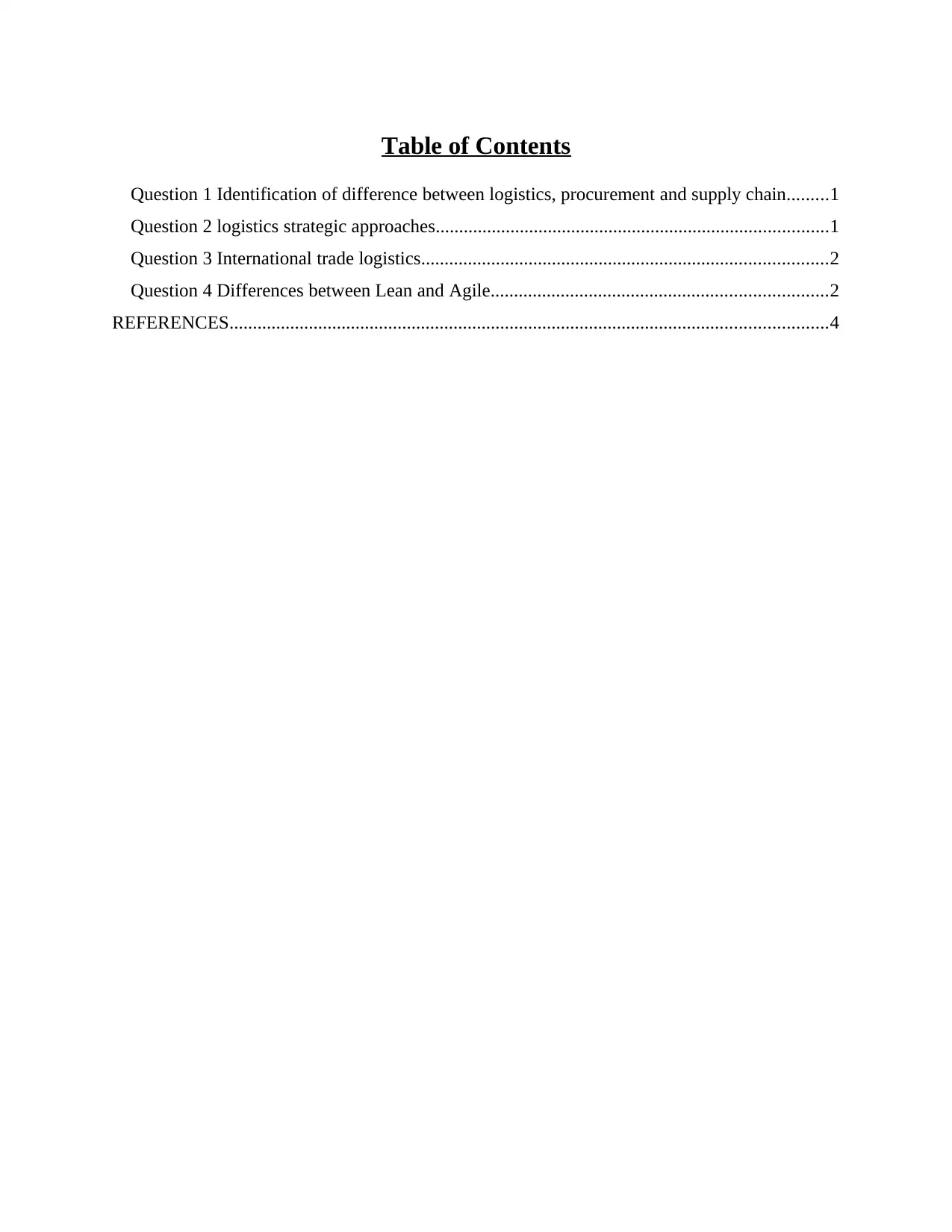
Table of Contents
Question 1 Identification of difference between logistics, procurement and supply chain.........1
Question 2 logistics strategic approaches....................................................................................1
Question 3 International trade logistics.......................................................................................2
Question 4 Differences between Lean and Agile........................................................................2
REFERENCES................................................................................................................................4
Question 1 Identification of difference between logistics, procurement and supply chain.........1
Question 2 logistics strategic approaches....................................................................................1
Question 3 International trade logistics.......................................................................................2
Question 4 Differences between Lean and Agile........................................................................2
REFERENCES................................................................................................................................4
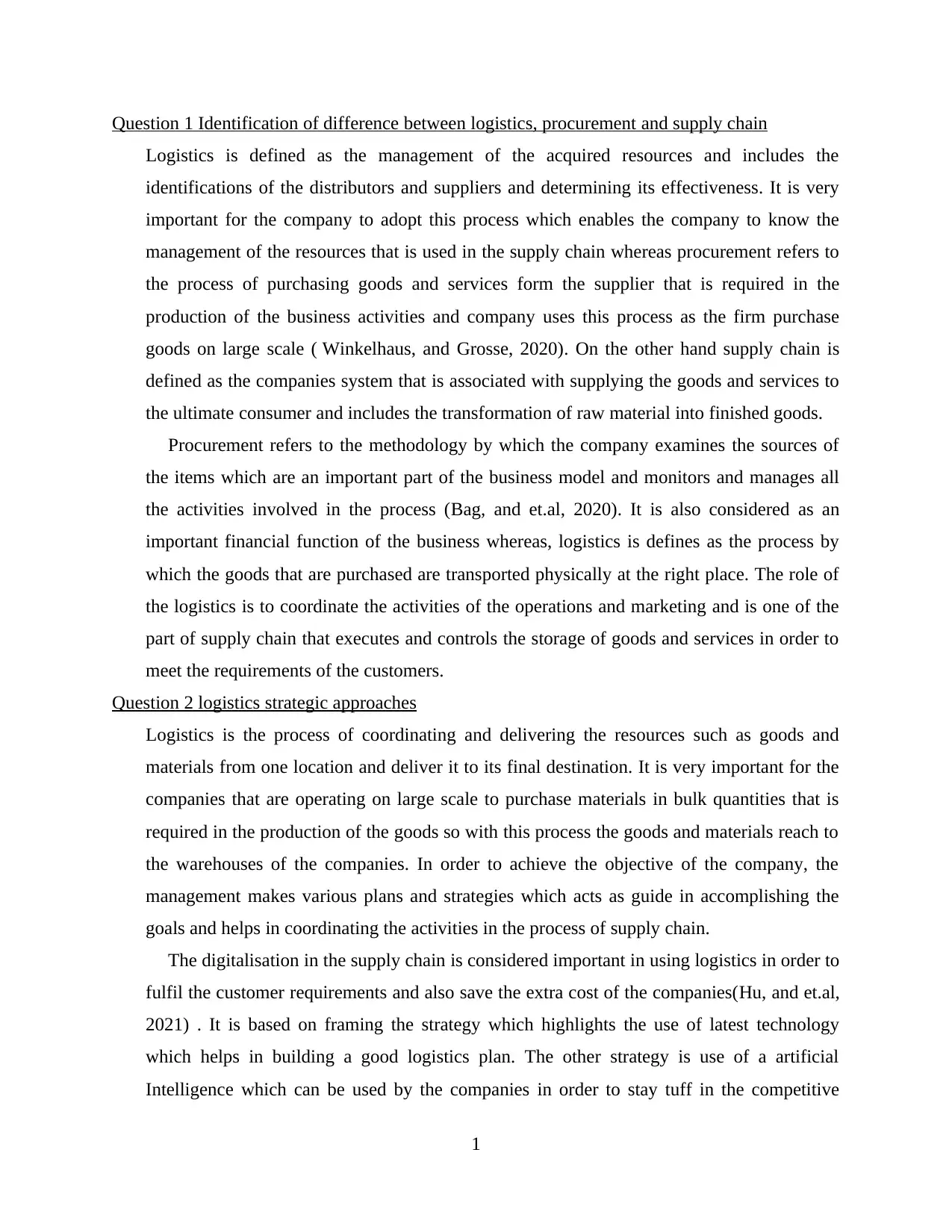
Question 1 Identification of difference between logistics, procurement and supply chain
Logistics is defined as the management of the acquired resources and includes the
identifications of the distributors and suppliers and determining its effectiveness. It is very
important for the company to adopt this process which enables the company to know the
management of the resources that is used in the supply chain whereas procurement refers to
the process of purchasing goods and services form the supplier that is required in the
production of the business activities and company uses this process as the firm purchase
goods on large scale ( Winkelhaus, and Grosse, 2020). On the other hand supply chain is
defined as the companies system that is associated with supplying the goods and services to
the ultimate consumer and includes the transformation of raw material into finished goods.
Procurement refers to the methodology by which the company examines the sources of
the items which are an important part of the business model and monitors and manages all
the activities involved in the process (Bag, and et.al, 2020). It is also considered as an
important financial function of the business whereas, logistics is defines as the process by
which the goods that are purchased are transported physically at the right place. The role of
the logistics is to coordinate the activities of the operations and marketing and is one of the
part of supply chain that executes and controls the storage of goods and services in order to
meet the requirements of the customers.
Question 2 logistics strategic approaches
Logistics is the process of coordinating and delivering the resources such as goods and
materials from one location and deliver it to its final destination. It is very important for the
companies that are operating on large scale to purchase materials in bulk quantities that is
required in the production of the goods so with this process the goods and materials reach to
the warehouses of the companies. In order to achieve the objective of the company, the
management makes various plans and strategies which acts as guide in accomplishing the
goals and helps in coordinating the activities in the process of supply chain.
The digitalisation in the supply chain is considered important in using logistics in order to
fulfil the customer requirements and also save the extra cost of the companies(Hu, and et.al,
2021) . It is based on framing the strategy which highlights the use of latest technology
which helps in building a good logistics plan. The other strategy is use of a artificial
Intelligence which can be used by the companies in order to stay tuff in the competitive
1
Logistics is defined as the management of the acquired resources and includes the
identifications of the distributors and suppliers and determining its effectiveness. It is very
important for the company to adopt this process which enables the company to know the
management of the resources that is used in the supply chain whereas procurement refers to
the process of purchasing goods and services form the supplier that is required in the
production of the business activities and company uses this process as the firm purchase
goods on large scale ( Winkelhaus, and Grosse, 2020). On the other hand supply chain is
defined as the companies system that is associated with supplying the goods and services to
the ultimate consumer and includes the transformation of raw material into finished goods.
Procurement refers to the methodology by which the company examines the sources of
the items which are an important part of the business model and monitors and manages all
the activities involved in the process (Bag, and et.al, 2020). It is also considered as an
important financial function of the business whereas, logistics is defines as the process by
which the goods that are purchased are transported physically at the right place. The role of
the logistics is to coordinate the activities of the operations and marketing and is one of the
part of supply chain that executes and controls the storage of goods and services in order to
meet the requirements of the customers.
Question 2 logistics strategic approaches
Logistics is the process of coordinating and delivering the resources such as goods and
materials from one location and deliver it to its final destination. It is very important for the
companies that are operating on large scale to purchase materials in bulk quantities that is
required in the production of the goods so with this process the goods and materials reach to
the warehouses of the companies. In order to achieve the objective of the company, the
management makes various plans and strategies which acts as guide in accomplishing the
goals and helps in coordinating the activities in the process of supply chain.
The digitalisation in the supply chain is considered important in using logistics in order to
fulfil the customer requirements and also save the extra cost of the companies(Hu, and et.al,
2021) . It is based on framing the strategy which highlights the use of latest technology
which helps in building a good logistics plan. The other strategy is use of a artificial
Intelligence which can be used by the companies in order to stay tuff in the competitive
1
⊘ This is a preview!⊘
Do you want full access?
Subscribe today to unlock all pages.

Trusted by 1+ million students worldwide
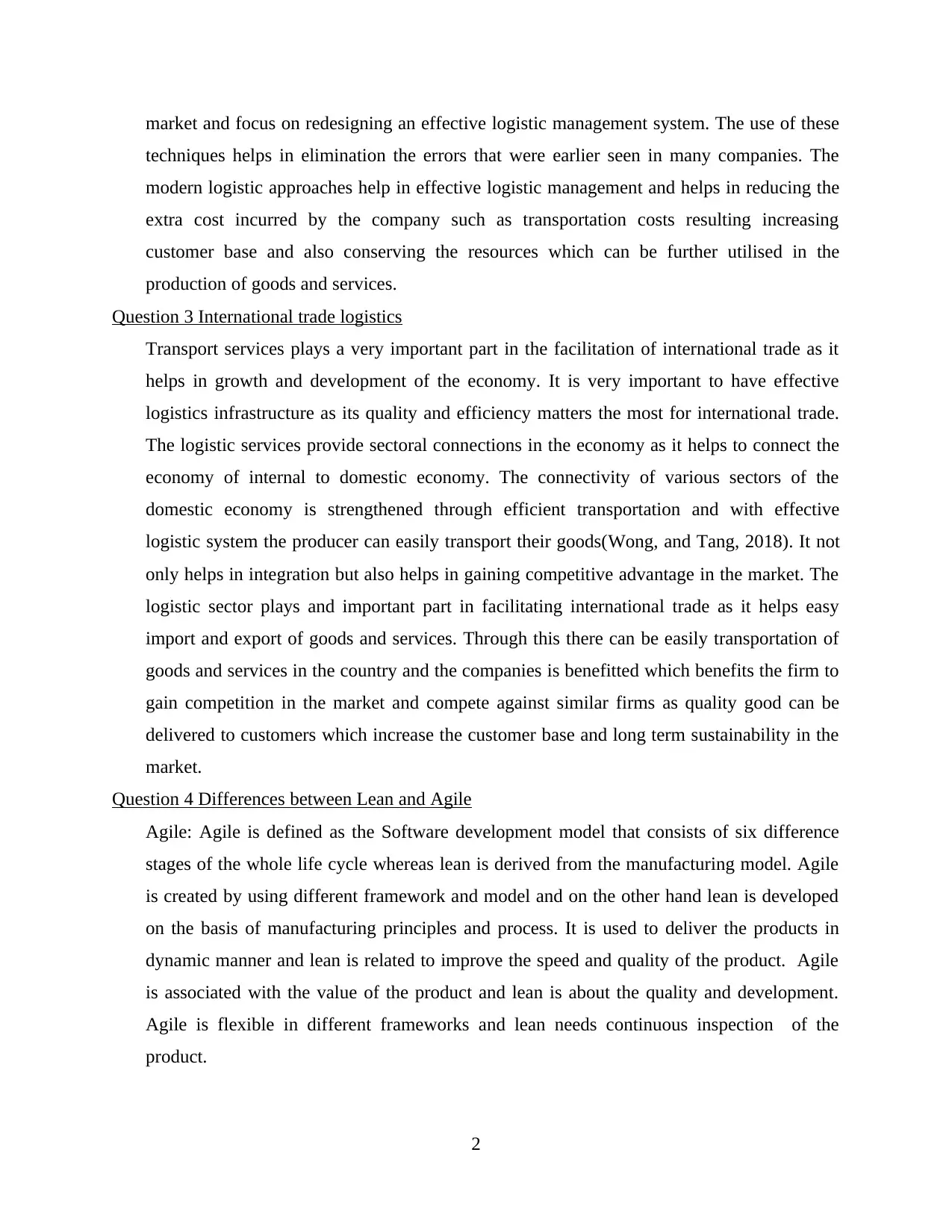
market and focus on redesigning an effective logistic management system. The use of these
techniques helps in elimination the errors that were earlier seen in many companies. The
modern logistic approaches help in effective logistic management and helps in reducing the
extra cost incurred by the company such as transportation costs resulting increasing
customer base and also conserving the resources which can be further utilised in the
production of goods and services.
Question 3 International trade logistics
Transport services plays a very important part in the facilitation of international trade as it
helps in growth and development of the economy. It is very important to have effective
logistics infrastructure as its quality and efficiency matters the most for international trade.
The logistic services provide sectoral connections in the economy as it helps to connect the
economy of internal to domestic economy. The connectivity of various sectors of the
domestic economy is strengthened through efficient transportation and with effective
logistic system the producer can easily transport their goods(Wong, and Tang, 2018). It not
only helps in integration but also helps in gaining competitive advantage in the market. The
logistic sector plays and important part in facilitating international trade as it helps easy
import and export of goods and services. Through this there can be easily transportation of
goods and services in the country and the companies is benefitted which benefits the firm to
gain competition in the market and compete against similar firms as quality good can be
delivered to customers which increase the customer base and long term sustainability in the
market.
Question 4 Differences between Lean and Agile
Agile: Agile is defined as the Software development model that consists of six difference
stages of the whole life cycle whereas lean is derived from the manufacturing model. Agile
is created by using different framework and model and on the other hand lean is developed
on the basis of manufacturing principles and process. It is used to deliver the products in
dynamic manner and lean is related to improve the speed and quality of the product. Agile
is associated with the value of the product and lean is about the quality and development.
Agile is flexible in different frameworks and lean needs continuous inspection of the
product.
2
techniques helps in elimination the errors that were earlier seen in many companies. The
modern logistic approaches help in effective logistic management and helps in reducing the
extra cost incurred by the company such as transportation costs resulting increasing
customer base and also conserving the resources which can be further utilised in the
production of goods and services.
Question 3 International trade logistics
Transport services plays a very important part in the facilitation of international trade as it
helps in growth and development of the economy. It is very important to have effective
logistics infrastructure as its quality and efficiency matters the most for international trade.
The logistic services provide sectoral connections in the economy as it helps to connect the
economy of internal to domestic economy. The connectivity of various sectors of the
domestic economy is strengthened through efficient transportation and with effective
logistic system the producer can easily transport their goods(Wong, and Tang, 2018). It not
only helps in integration but also helps in gaining competitive advantage in the market. The
logistic sector plays and important part in facilitating international trade as it helps easy
import and export of goods and services. Through this there can be easily transportation of
goods and services in the country and the companies is benefitted which benefits the firm to
gain competition in the market and compete against similar firms as quality good can be
delivered to customers which increase the customer base and long term sustainability in the
market.
Question 4 Differences between Lean and Agile
Agile: Agile is defined as the Software development model that consists of six difference
stages of the whole life cycle whereas lean is derived from the manufacturing model. Agile
is created by using different framework and model and on the other hand lean is developed
on the basis of manufacturing principles and process. It is used to deliver the products in
dynamic manner and lean is related to improve the speed and quality of the product. Agile
is associated with the value of the product and lean is about the quality and development.
Agile is flexible in different frameworks and lean needs continuous inspection of the
product.
2
Paraphrase This Document
Need a fresh take? Get an instant paraphrase of this document with our AI Paraphraser
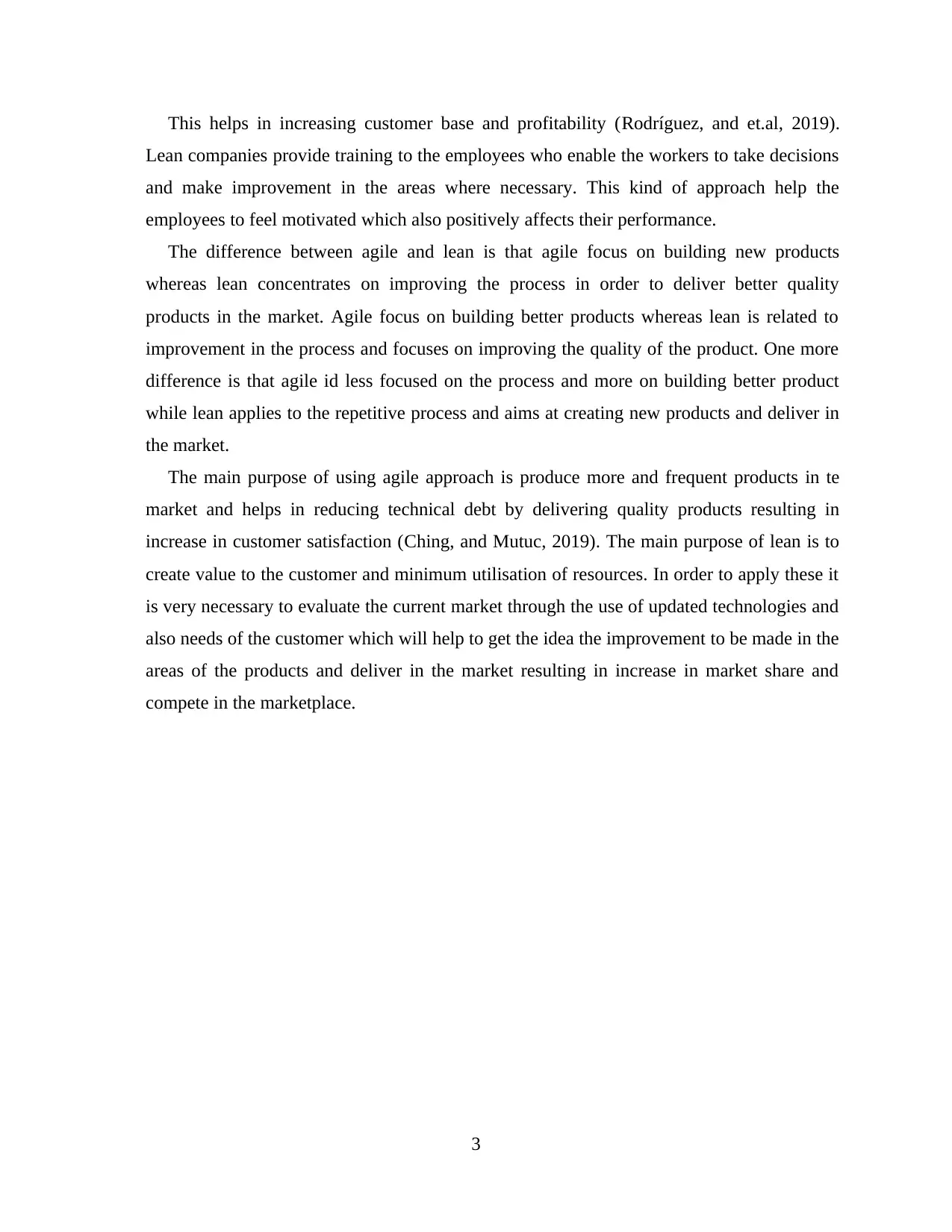
This helps in increasing customer base and profitability (Rodríguez, and et.al, 2019).
Lean companies provide training to the employees who enable the workers to take decisions
and make improvement in the areas where necessary. This kind of approach help the
employees to feel motivated which also positively affects their performance.
The difference between agile and lean is that agile focus on building new products
whereas lean concentrates on improving the process in order to deliver better quality
products in the market. Agile focus on building better products whereas lean is related to
improvement in the process and focuses on improving the quality of the product. One more
difference is that agile id less focused on the process and more on building better product
while lean applies to the repetitive process and aims at creating new products and deliver in
the market.
The main purpose of using agile approach is produce more and frequent products in te
market and helps in reducing technical debt by delivering quality products resulting in
increase in customer satisfaction (Ching, and Mutuc, 2019). The main purpose of lean is to
create value to the customer and minimum utilisation of resources. In order to apply these it
is very necessary to evaluate the current market through the use of updated technologies and
also needs of the customer which will help to get the idea the improvement to be made in the
areas of the products and deliver in the market resulting in increase in market share and
compete in the marketplace.
3
Lean companies provide training to the employees who enable the workers to take decisions
and make improvement in the areas where necessary. This kind of approach help the
employees to feel motivated which also positively affects their performance.
The difference between agile and lean is that agile focus on building new products
whereas lean concentrates on improving the process in order to deliver better quality
products in the market. Agile focus on building better products whereas lean is related to
improvement in the process and focuses on improving the quality of the product. One more
difference is that agile id less focused on the process and more on building better product
while lean applies to the repetitive process and aims at creating new products and deliver in
the market.
The main purpose of using agile approach is produce more and frequent products in te
market and helps in reducing technical debt by delivering quality products resulting in
increase in customer satisfaction (Ching, and Mutuc, 2019). The main purpose of lean is to
create value to the customer and minimum utilisation of resources. In order to apply these it
is very necessary to evaluate the current market through the use of updated technologies and
also needs of the customer which will help to get the idea the improvement to be made in the
areas of the products and deliver in the market resulting in increase in market share and
compete in the marketplace.
3
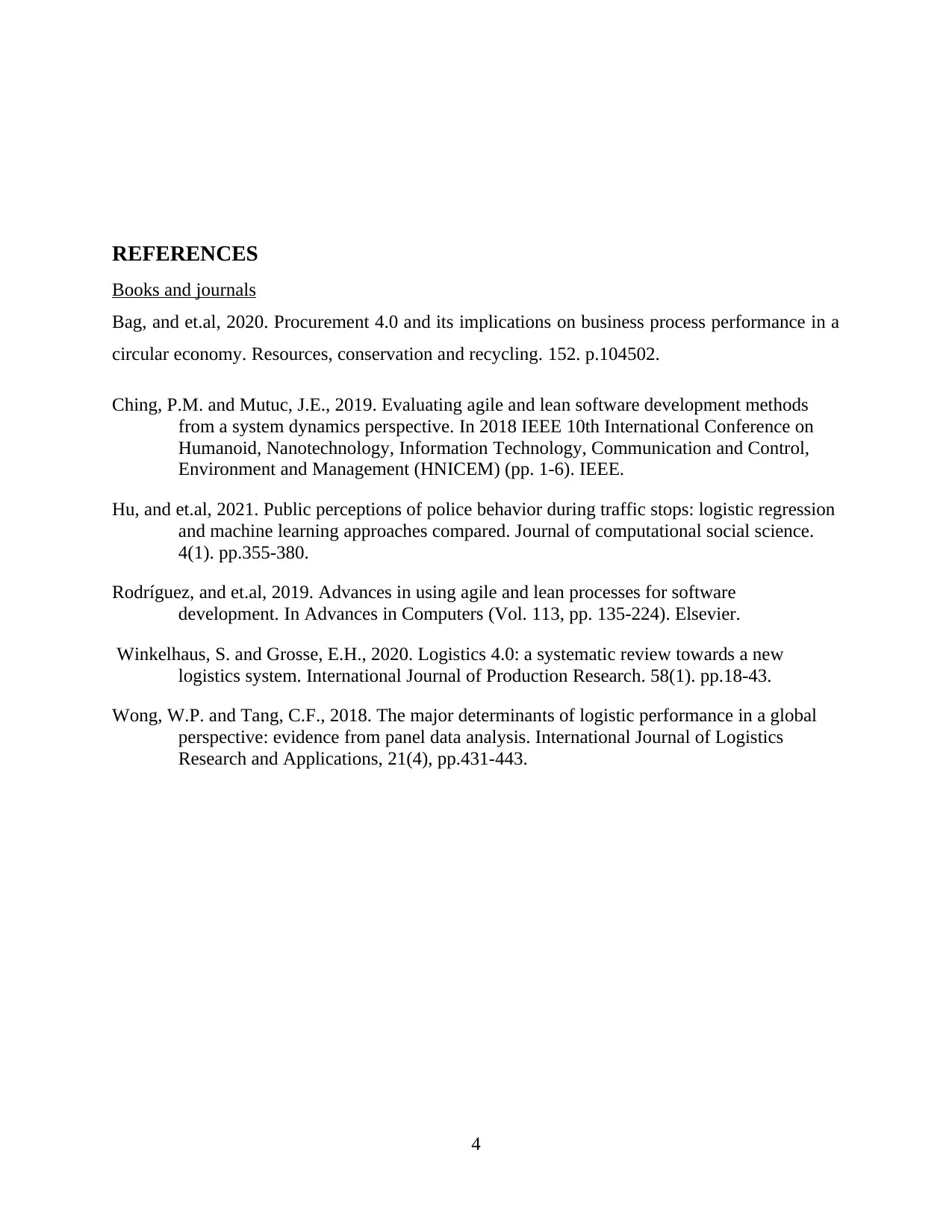
REFERENCES
Books and journals
Bag, and et.al, 2020. Procurement 4.0 and its implications on business process performance in a
circular economy. Resources, conservation and recycling. 152. p.104502.
Ching, P.M. and Mutuc, J.E., 2019. Evaluating agile and lean software development methods
from a system dynamics perspective. In 2018 IEEE 10th International Conference on
Humanoid, Nanotechnology, Information Technology, Communication and Control,
Environment and Management (HNICEM) (pp. 1-6). IEEE.
Hu, and et.al, 2021. Public perceptions of police behavior during traffic stops: logistic regression
and machine learning approaches compared. Journal of computational social science.
4(1). pp.355-380.
Rodríguez, and et.al, 2019. Advances in using agile and lean processes for software
development. In Advances in Computers (Vol. 113, pp. 135-224). Elsevier.
Winkelhaus, S. and Grosse, E.H., 2020. Logistics 4.0: a systematic review towards a new
logistics system. International Journal of Production Research. 58(1). pp.18-43.
Wong, W.P. and Tang, C.F., 2018. The major determinants of logistic performance in a global
perspective: evidence from panel data analysis. International Journal of Logistics
Research and Applications, 21(4), pp.431-443.
4
Books and journals
Bag, and et.al, 2020. Procurement 4.0 and its implications on business process performance in a
circular economy. Resources, conservation and recycling. 152. p.104502.
Ching, P.M. and Mutuc, J.E., 2019. Evaluating agile and lean software development methods
from a system dynamics perspective. In 2018 IEEE 10th International Conference on
Humanoid, Nanotechnology, Information Technology, Communication and Control,
Environment and Management (HNICEM) (pp. 1-6). IEEE.
Hu, and et.al, 2021. Public perceptions of police behavior during traffic stops: logistic regression
and machine learning approaches compared. Journal of computational social science.
4(1). pp.355-380.
Rodríguez, and et.al, 2019. Advances in using agile and lean processes for software
development. In Advances in Computers (Vol. 113, pp. 135-224). Elsevier.
Winkelhaus, S. and Grosse, E.H., 2020. Logistics 4.0: a systematic review towards a new
logistics system. International Journal of Production Research. 58(1). pp.18-43.
Wong, W.P. and Tang, C.F., 2018. The major determinants of logistic performance in a global
perspective: evidence from panel data analysis. International Journal of Logistics
Research and Applications, 21(4), pp.431-443.
4
⊘ This is a preview!⊘
Do you want full access?
Subscribe today to unlock all pages.

Trusted by 1+ million students worldwide

5
1 out of 7
Related Documents
Your All-in-One AI-Powered Toolkit for Academic Success.
+13062052269
info@desklib.com
Available 24*7 on WhatsApp / Email
![[object Object]](/_next/static/media/star-bottom.7253800d.svg)
Unlock your academic potential
Copyright © 2020–2025 A2Z Services. All Rights Reserved. Developed and managed by ZUCOL.




